Your vape mod or battery may provide the power for your vaping, but tanks do the actual vaping part. This is why finding the best vape tank is absolutely crucial to getting a good experience, and the good news is that there are plenty of options to choose from.
These options cover various experience levels too, with sub-ohm tanks being the best option for a simple, fill-up and vape type experience, rebuildable tank atomizers (RTAs and RDTAs) allowing you to build your own coil but still working like a sub-ohm tank once it’s done, and rebuildable dripping atomizers (RDAs) letting you make your own coil and drip juice directly onto the coils.
The huge range of options is great, but navigating them can be a challenge, especially if you haven’t bought many vape tanks before. But this article is here to help you get the best vape tank for your needs, with a brief run-down of each option, arranged in sections and with links to longer lists if you want more options. So let’s dive in!
Best Sub-Ohm Vape Tanks
Here are our top three picks for sub-ohm tanks. You can get more recommendations in the full list of the best sub ohm vape tanks.
Smok TFV16
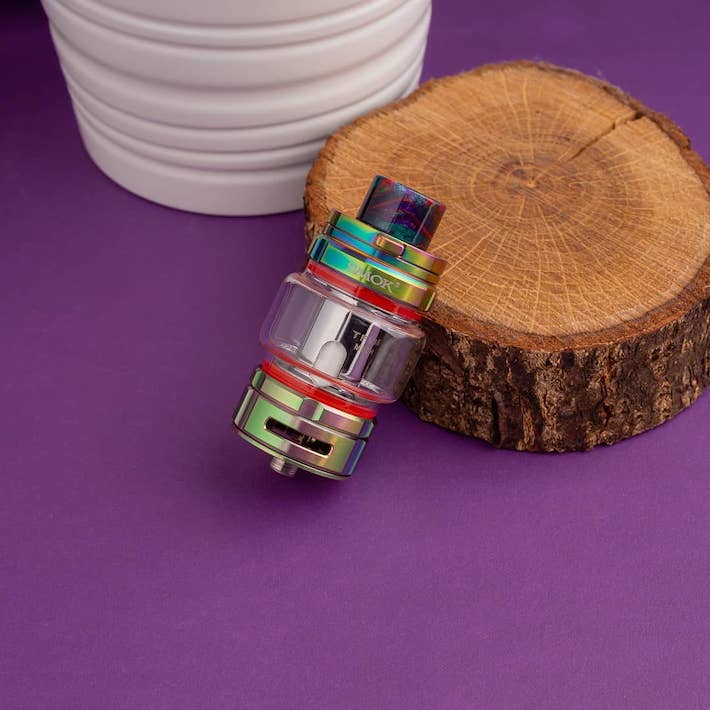
You can pick up the Smok TFV16 for $25.95.
Every TFV sub ohm tank from Smok has been a pretty solid option at the time it was released, and the TFV16 is no different. It keeps much of the design features you’ll be familiar with if you’ve used a tank from the line-up before, including the rotating top-filling design (complete with a button to lock it), the simple-but-effective slot-style adjustable airflow and the bubble glass tank. The TFV16 is especially big, with a 28 mm base diameter (increasing to 32 mm at the largest part of the bubble) and a huge 9 ml juice capacity, so you won’t be constantly refilling. There’s also a protective sleeve included so you’re protected against drops and knocks.
The TFV16 comes with two coils: one 0.17 ohm single mesh option and one 0.12 ohm dual mesh coil. Both of these offer the benefits of mesh coils – notably improved vapor production and excellent flavor – but the lower-resistance option really hits the peak when it comes to performance. The adjustable airflow system gives you some control over your draw, but like most sub ohm tanks it’s not really ideal for mouth-to-lung (MTL) inhales even if you close it off quite a bit. But paired with a powerful mod you’ll definitely be impressed with what it can do.
GeekVape Cerberus

You can pick up the GeekVape Cerberus for $32.90.
GeekVape has put out plenty of excellent tanks and atomizers over the years, and their entry into the sub ohm tank section of this best vape tank run-down comes in the form of the Cerberus. The design is right in line with what you’d expect from a sub ohm tank these days, with a bubble glass tank in the middle, a slot-style adjustable airflow system built into the base and a wide-bore drip tip with a top-filling system at the top. The mouthpiece and top cap unscrew to reveal a couple of fill holes, and the tank can hold 5.5 ml of e-juice (and you get a straight-sided 4 ml tank if you prefer, too).
The Cerberus comes with a 0.2 ohm mesh coil, which offers exceptional performance, especially around the 60 to 80 W range. The tank only comes with the one coil, but it does a great job and you can also use TFV8 Baby coils in the tank, which is a big bonus if you can find them more easily or you have some old ones lying around.
HellVape Hellbeast
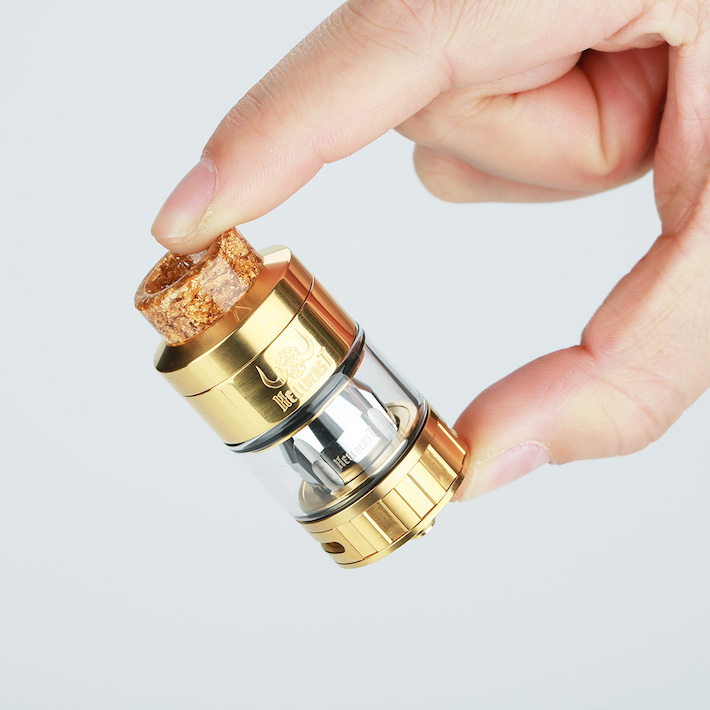
You can pick up the HellVape Hellbeast for $35.99.
The Hellbeast from HellVape is another major contender when it comes to the best vape tanks, with an awesome design and tons of flexibility in terms of how you want to vape. It has a normal enough look, with a slightly larger metallic section on the top than many sub ohm tank devices, but with the usual slot-style airflow system around the base, and a push-to-open top filling system. The tank is straight-sided, holding 4 ml of e-juice, and it has the same uniform 24 mm diameter as the rest of the tank. This means it fits pretty well on most mods or even many modern vape pen like devices.
The best thing about the Hellbeast, though, is the wide compatibility with other coils. You get two 0.2 ohm coils included with the tank, but it’s compatible with Smok Baby and Vaporesso GT coils, as well as coming with an adapter so you can also use it with Nautilus coils. This might not seem like such a huge deal, but the vaping industry moves quickly, so having plenty of options to keep getting new coils for your tank is really useful. The performance is also excellent, and even though it uses honeycomb airholes you still get plenty of vapor. This also makes it more plausible to use with MTL inhales, another huge benefit.
Best RDA Vape Tanks
Here are the top three RDA vapes. You can see more of the best vape tanks for RDAs in the full list.
GrimmGreen x OhmBoy Recoil Rebel
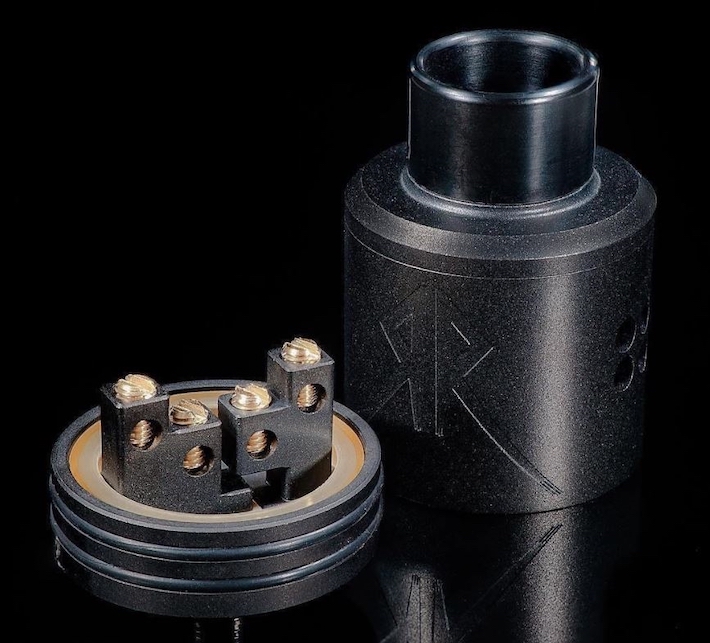
Get the Recoil Rebel for $49.95.
The Recoil Rebel is one of the few modern RDA devices that have something of a traditional design, with standard-style posts and a layout you’ll be right at home with if you have any experience with rebuilding. It has a 22 mm build deck, with a “three post” design that’s really better to think of as a four-post design because the center post is split to make dual-coil builds easier. Each post-hole is controlled with a flat-head screw point on the top, with 2.5 mm holes so you can use most wire types in your build.
From the outside it looks pretty standard, although it uses airholes instead of slots, with a downwards angle to them so you get good exposure for your coils. The RDA also comes with two top caps (“Flavor Bro” and “Clouds Bro,” kind of self explanatory) so you can have even more control over your vaping experience with the Rebel. The result is a pretty intuitive but clearly carefully-designed RDA that offers excellent performance without compromising user friendliness.
GeekVape Baron
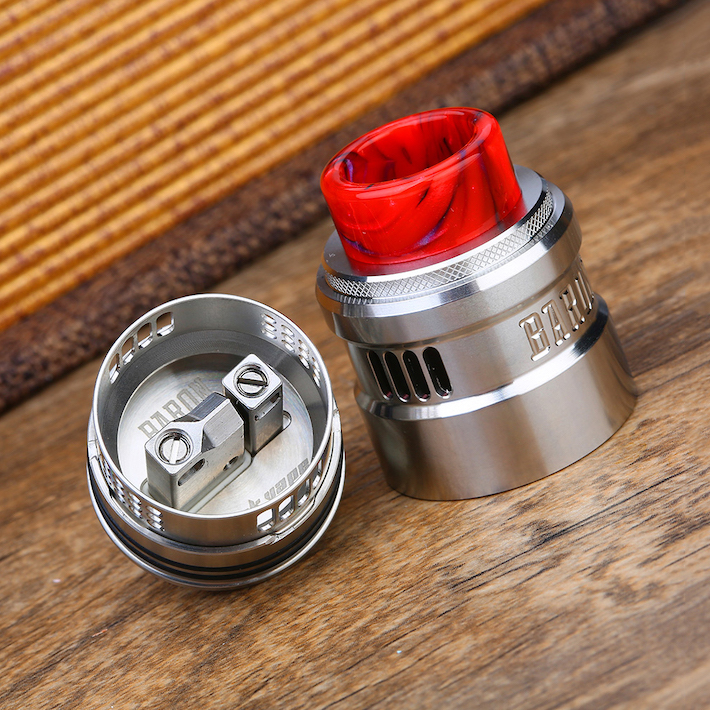
You can pick up the Baron tank for $27.90.
The Baron from GeekVape is a pretty standard-looking RDA with some great extra features that push it far beyond the standard offerings. Most notably, they’ve taken care over the airflow system to give you plenty of control and more options than most devices. This is mediated by an inner sleeve, which has two different choices for airflow: vertical strips that work more like traditional RDA airflow systems and an array of holes more like a honeycomb system. You can use the main top cap to close some of these off, and the airholes open up on either side of your coil.
The Baron has a 24 mm diameter deck, with a basic two-post design that most vapers who’ve used RDAs before will be right at home with. The center post is wider, with the terminal actually off to one side of the deck, and the negative post is on the opposite side. This basically forms a line across the center of the deck, allowing dual-coil builds with two coil-legs in each of the post-holes. It balances familiar design elements with subtle improvements, putting it comfortably up there with the best RDAs on the market, and you also get tons of extras – including cotton, pre-made coils and a 510 drip tip adapter – to sweeten the deal.
District F5ve Layercake
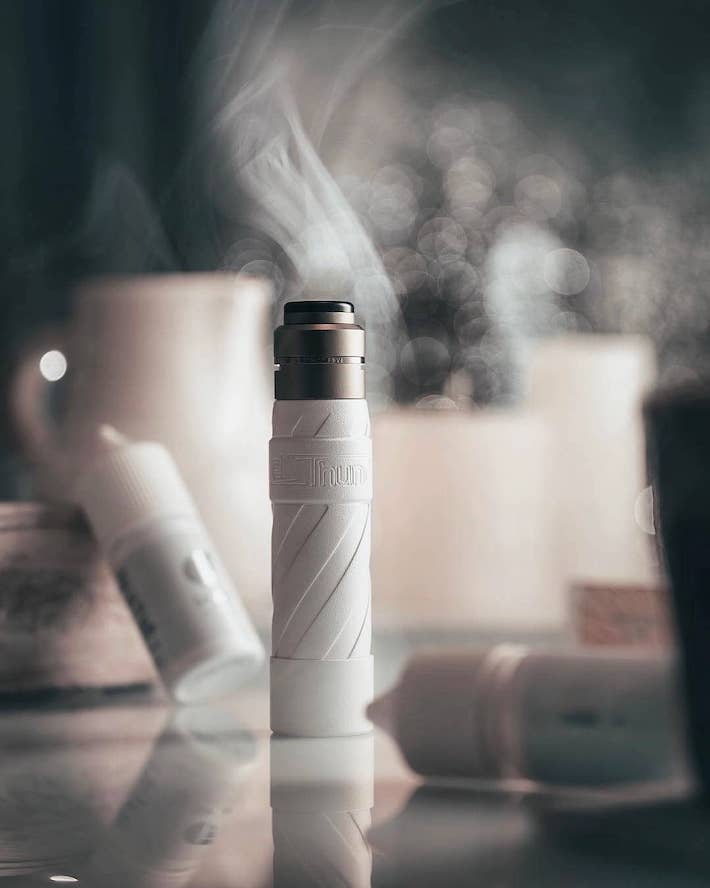
The Layercake from District F5ve is one of the best RDA devices on the market largely because of its unique design, which makes building as easy as possible without compromising on performance. The RDA has a 24 mm diameter, with a pretty small body and a post made from “ceramisteel,” an insulated material made by District F5ve intended to balance impressive heat resistance with strength. The RDA has an internal sleeve to give you control over its twin slot-style airflow holes, and a two-piece 810 drip tip that increases heat resistance.
The deck is the most interesting part of the RDA, though: it has a single post design, with one screw in the middle of two vise-like plates that hold you coil in place. This makes building about as easy it as it can get, not only giving you tons of room to use different wire types, but most of all removing basically all of the need for accuracy when you insert the legs of your coil – you can connect your coil’s legs wherever it works for your build.
Best RTA Vape Tanks
See our top three picks for RTA vapes below. Check out the full best RTA vapes list for more recommendations!
Dovpo Blotto
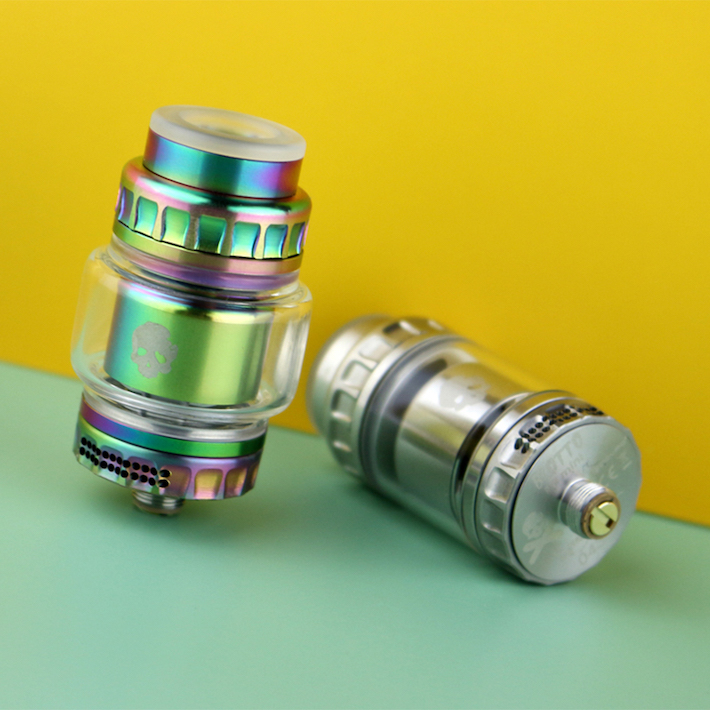
You can pick up the tank for $29.99.
The Blotto from Dovpo looks kind of cool from the outside (depending on your preferences, of course), but it really comes into its own as one of the best vape tanks in the RTA class when you start to look at the details. The deck is a two-post design, but this really doesn’t capture the reality of what’s going on: there are two horn-shaped towers at either side of a curved base, with an array of airflow holes running up their insides. The base also has airflow inlet slots right across, and the result is that your coils have air hitting them from 242 degrees around. This leads to impressive vapor production and flavor, with airflow coverage you can’t really find in any other device on the market.
The airflow design is admittedly impressive, but the design also works well when it comes to giving you enough space for your builds, with a total of four terminals on the sides of the raised towers. This is perfect for dual coil builds but you can also get some excellent results with single-coil builds too. The tank itself has a 4 ml capacity with the (included) bubble glass tube, but you also get a 2 ml capacity straight-sided tube too.
Oumier Wasp Nano
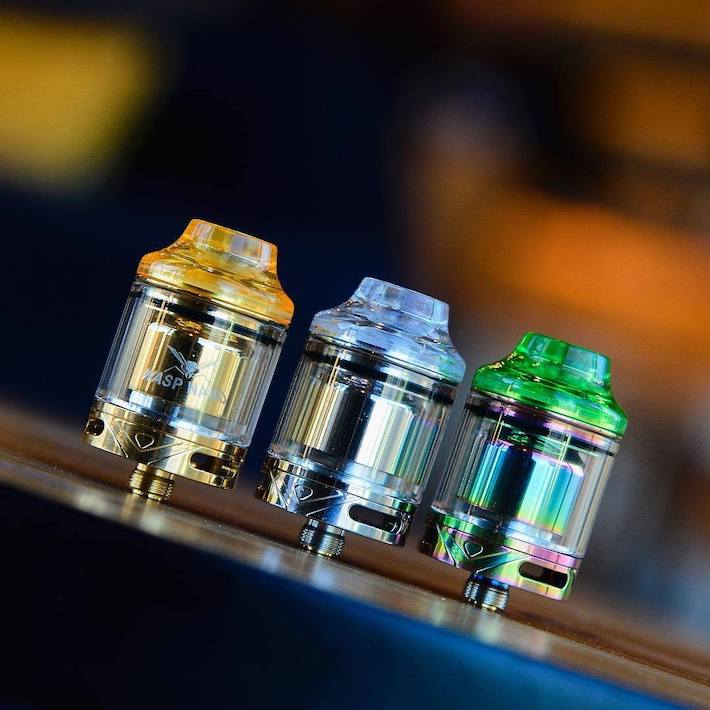
You can pick up the Wasp Nano for $19.99, which is a great price for one of the best vape tanks on the market.
The Wasp Nano from Oumier is basically the RTA version of the dripping atomizer of the same name, but with the same deck design put into tank form, it stands head and shoulders above many of the options on the market. It isn’t as huge as many of the vape tanks around these days, with a 2 ml capacity and just a 23 mm diameter, but if you’re looking for a compact RTA it’s a great option. It has an unscrew-to-access top-filling system, located just below the glass mouthpiece, and there’s a triple-slot adjustable airflow system around the base.
The deck has a two post design, with one terminal in each post so it’s really only for single-coil builds. The posts are pretty big though, basically running from one end of the deck to the other, with a channel left in the center for your coil. This is to support the side-coil airflow, with an air outlet in the center of each post, so you get two streams of air directly onto your coil, producing great flavor and vapor production. There are two sizable wicking ports at either end of the central channel, so it’s pretty easy to get everything set up.
Hellvape x Heathen Dead Rabbit V2
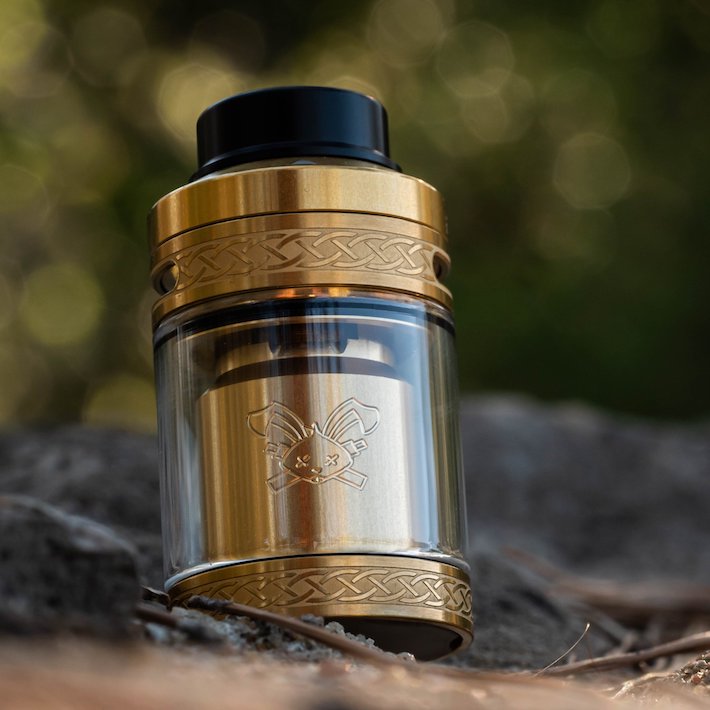
You can pick the Dead Rabbit V2 tank for $34.99.
The Dead Rabbit V2 RTA is a rebuildable tank atomizer modeled after the RDA of the same name, bringing the unique deck design the tank is known for into the world of tank atomizers. The basic design is right in line with most of the RTAs on the market, with a central build chamber, a slot-style adjustable airflow system and a choice between straight-sided (2 ml) and bubble glass (5 ml) tanks. The airflow slots have been moved to the top of the device, though, which helps to reduce (and basically eliminate) leaking while still offering excellent airflow.
The deck has the rabbit ear style design the Dead Rabbit is known for, with four posts sticking up out of the base, with the tops bent off to the side so the post holes point straight upwards. This might not seem like such a huge benefit, but it drastically increases the space you have for your builds. Since the Dead Rabbit V2 is designed for dual coil builds, this is very useful and puts it head and shoulders above many of the best RTA vape tanks out there. The performance depends on your build, of course, but generally the result of a build on the Dead Rabbit V2 is hard to fault.
Guide to Buying the Best Vape Tank
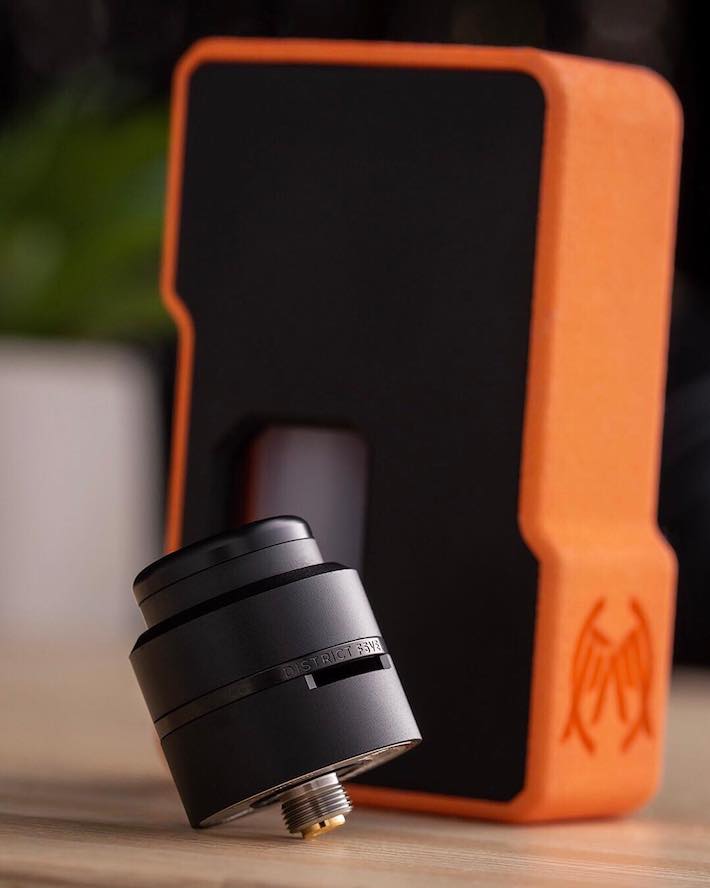
Since your tank is probably the most important part of your whole setup, it makes sense to take a little time over your decision.
If you’re new to buying vaping equipment or you’ve made a bad purchase or two in the past, it’s a good idea to think a bit more before hitting the “Buy” button.
As well as checking out reviews and recommendations (which is always worthwhile), here are a few things to think about before you make the purchase.
What Type of Tank?
This is the easiest question to answer, because it basically comes down to one question: do you want to make your own coils?
If you don’t, then either a sub-ohm or mouth-to-lung (MTL) tank is the best choice for you. All you have to do is connect the pre-made coil, fill up the tank with your favorite e-liquid flavor and start to vape. When the coil dies (usually after a few weeks or a month), then you replace it and continue. Sub ohm tanks are basically just those with lower resistance, and are usually tailored to “direct to lung” hits, while higher-resistance options suit cigarette-like, MTL hits.
If you do want to build your coils, then an RDA, RTA or RDTA (rebuildable dripping, rebuildable tank or rebuildable dripping tank, respectively) are the best options for you.
The choice between these essentially depends on your preferences. RDAs are generally the easiest to build on, followed by RDTAs and finally RTAs.
The downside is that RDAs require you to drip new e-liquid onto the wicks every 5 to 10 puffs (depending on the juice well size and a bunch of other stuff), while RTAs work basically like a sub ohm tank once you’ve got your coil set up.
RDTAs are somewhere in the middle, because you (usually) have to tilt the tank to re-soak the wicks after a few puffs, but you still have a tank of e-juice to work with so you can get by without the bottle by your side for a while.
If you’re not sure whether you want to make your own coils, the main benefits are that its way cheaper over the long term and that the performance is generally better.
You can also make your coils to suit your preferences, trying new styles and builds until you find something that really works for you.
It is admittedly more work – and definitely more hands-on – than using pre-made coils, but there’s a reason that many vapers still do it, and it’s not very difficult after your first few builds.
Size (Sort of) Matters
One of the easiest things to think about is how big the tank is, or for RDAs the size of the “juice well.”
Generally here, bigger is better. Kind of obviously, the bigger the tank the less often you’ll have to mess around refilling. This isn’t necessarily a good thing, though – if you like to change flavor regularly, a smaller tank might be better for you. With this in mind, 4 to 5 ml is a pretty good middle-ground for most vapers’ purposes.
A “juice well” on an RDA is basically the word for the raised section around the base. They allow you to “over-drip,” so that the wicks are completely soaked but there’s still some e-liquid pooled in the bottom ready to use. There’s no real downside to a bigger juice well – it just means you have to drip less often, but you can always change flavor pretty quickly if you want to.
Airflow Options
The airflow to your coils is one of the most important factors in determining the type of vape you’ll get.
Broadly speaking, more airflow leads to bigger clouds but it can reduce the flavor a little in some cases, whereas restricted airflow is better for flavor and MTL hits.
But the good news is that regardless of which you prefer, you basically want the same thing: a tank with a good adjustable airflow system. These let you control the amount of air reaching your coil, so you can make the setup work with your preferences pretty easily.
Most adjustable airflow systems have a couple of slots you can close off or open up to change the airflow, but there are unique designs. Some have arrays of little holes, some have vertical slots and some do something else entirely.
Choosing between these is a little difficult without experience, but generally speaking all can work really well, provided you can adjust how much of it is open.
The other thing to think about is where the air outlet is on the inside of the tank. Under-coil airflow is often preferable, because it creates a direct path from the airhole to the coil and the mouthpiece, but you can get great results with side airflow systems too.
Again this can be a challenge to choose if you don’t have much experience, but at least you’ll understand why companies go on about it so much.
Think About the Coils
If you’re using a sub ohm tank, the type of coils available for the tank you choose is a key factor in how well it will perform.
Mesh coils are the darling of the industry at the time of writing because they make the whole process more efficient by having a lot of coil surface area in contact with the wick. They also tend to last a little longer than ordinary coil types, and the flavor is generally improved too.
However, there are many varying opinions on this, and in recent memory, Clapton coils, in particular, were favored for similar reasons. And even a “standard” coil or dual coil can still perform really well.
It should be becoming clear that coil type choice isn’t an exact science. While mesh coils do – in my experience – live up to the hype, you shouldn’t feel compelled to choose one specific type of coil over another.
However, the resistance of the coil is a much simpler way to get an idea of what the performance will be like without personal experience.
Generally speaking, lower-resistance coils will produce more vapor and have more space within the coil for airflow. This is one of the reasons that sub ohm tanks often aren’t ideal for MTL vaping.
Higher-resistance coils, on the other hand, tend to be more restricted in terms of airflow and work well with lower wattage settings.
A final thing to consider is how long the coils will last. This is hard to estimate, but it’s a good reason to check out some reviews of the specific tank you’re considering. If coils are prone to dying early, then you’ll end up spending a lot more over time.
RTAs vs. RDTAs
If you’re thinking that you want to make your own coils but not have to drip constantly, the two options – RDAs and RDTAs – might seem pretty similar. And they are, really.
But there is a key difference: after the setup, RTAs work just like sub ohm tanks, while RDTAs bridge the gap between RDAs and RTAs. The chamber of an RTA basically fills the role of an atomizer head in a sub ohm tank, so once you’ve finished your build, you put the cover on the deck and vape like you ordinarily would.
RDTAs have more of an RDA-like deck above the tank – generally with more space to build – and holes in the floor of the deck to get e-juice from the tank below.
You can use stainless steel wire or another upright wicking material to automatically supply your wicks, but in most cases you’ll need to tilt the tank to re-soak the wicks every so often. This removes one of the main challenges of RTAs, getting the wicking to work well, but obviously leads to a little more work in-use to keep your wick wet.
Tips for Rebuildables
Choosing between the different rebuildable vape tanks on the market brings a lot of fairly unique issues. We won’t go into excruciating detail here but there are a few things to think about if you’re set on a rebuildable.
- Deck Layout: The most important thing about any rebuildable is the deck. The main way to tell one from the other is the number of posts. Two posts are pretty standard, but some have four posts and other have none, instead using holes directly in the deck to connect your coils. The location of these also gives you an idea of how you can build for the tank – for instance, two posts at either edge of the deck means your coil or coils go in the middle, while posts in the center are generally designed for a coil connected at either side.
- Post Holes: The size, position and number of the post holes adds to this factor. If you have two post holes per post on a two-post deck, you know it’s designed with dual coil builds in mind. If there’s just one in each, then it’s probably only a single-coil deck. The size of the post-holes is also important: bigger post-holes give you more options to use exotic and interesting wire types (e.g. twisted or Clapton wire), and also make it easier to get your coils in place.
- Airflow System: The considerations above about airflow are particularly important for rebuildables, especially RDAs and RTAs. Many RDAs have airflow holes directly at the side of the coils, and while this can certainly work well, options that channel the airflow downwards (either through an intermediary layer or just with angled slots) tend to perform better. Some also simply position the airflow holes lower, which brings a risk of leaking but offers great performance when it works.
- Mesh Builds: Along with the move towards mesh in the industry overall, some RDAs and RTAs are intended to build with mesh. These tend to use clamp-like posts instead of the traditional style, and even though they obviously work well for mesh, they’re also great for ordinary builds because they make it way easier to get your coils connected.
Price
Finally, it’s impossible to make any type of purchase without thinking about the price. For vape tanks, it’s generally not a huge issue because prices tend to stick around the $30 to $50 range. However, if you want to choose a cheaper (or more expensive) option, take extra care to check out reviews and lists of recommendations.
You can definitely get good devices for cheaper, and if you want something really high-end it can be worth paying more, but just be aware you’re taking an extra risk in either case.
There Are Vape Tanks for Everyone, You Just Need to Find Yours
The array of vape tanks on the market is pretty astounding. With tons of options of every type and staunch supporters of most specific models, making the choice isn’t especially easy.
However, if you take a bit of time over the decision, think about your past experiences and try not to get caught up in the hype around some options, you’ll find something that ticks all the right boxes for you. But trial and error is part of the game here, so don’t expect the perfect vape from your first purchase.

